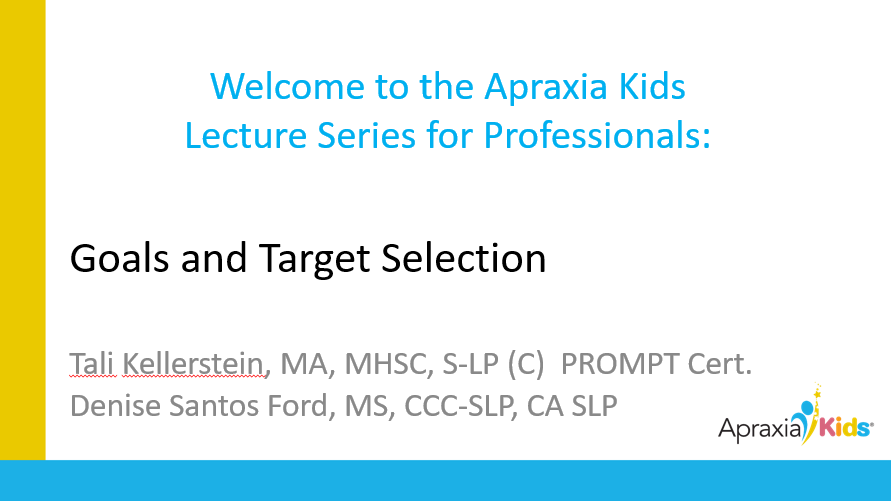
30 Jan Goals and Target Selection
Course Abstract:
This course encompassed treatment planning for children throughout their therapy journey. Specifically addressed were how to create goals, pick targets, and monitor progress for children who present with childhood apraxia of speech (CAS).
Because treatment can vary depending on severity and intelligibility levels, treatment in the previously mentioned areas was applied to children who are minimally verbal, children who are moderately verbal with decreased intelligibility, and children who are conversational with residual motor planning deficits. Examples of each severity level were shared.
To determine if treatment is progressing and if treatment should evolve, one must continually evaluate therapy and generalization outcomes. This session discussed how to evaluate ongoing treatment with probe data and how to appropriately apply that information.
Presented By:
Tali Kellerstein, MA, MHSC, S-LP (C) PROMPT Cert., Recognized by Apraxia Kids for Advanced Training and Expertise in Childhood Apraxia of Speech
Denise Santos Ford, MS, CCC-SLP, CA SLP, Recognized by Apraxia Kids for Advanced Training and Expertise in Childhood Apraxia of Speech
This course is offered for 0.15 ASHA CEUs (Introductory Level, Professional Area)
Learning Objectives
- Create 1 goal for each of the following: minimally verbal children, moderately verbal with decreased intelligibility, and conversational children with residual motor planning challenges.
- Develop 2 targets for individuals who are minimally verbal, moderately verbal with decreased intelligibility, and conversational children with residual motor planning challenges.
- Name at least 1 strategy for determining an individual’s progress and generalization.
Agenda
- Presentation (60 Minutes)
- Discuss evidence-based treatment practices for CAS
- Explore treatment strategies to use in practice with children with speech-motor learning difficulties
- Review common co-occurring challenges with CAS and therapy considerations
- Discussion (30 Minutes)
- Speakers, facilitators, and attendees discussed the session, shared resources and ideas, and asked/answered questions.
Course Abstract:
This course encompassed treatment planning for children throughout their therapy journey. Specifically addressed were how to create goals, pick targets, and monitor progress for children who present with childhood apraxia of speech (CAS).
Because treatment can vary depending on severity and intelligibility levels, treatment in the previously mentioned areas was applied to children who are minimally verbal, children who are moderately verbal with decreased intelligibility, and children who are conversational with residual motor planning deficits. Examples of each severity level were shared.
To determine if treatment is progressing and if treatment should evolve, one must continually evaluate therapy and generalization outcomes. This session discussed how to evaluate ongoing treatment with probe data and how to appropriately apply that information.
Presented By:
Tali Kellerstein, MA, MHSC, S-LP (C) PROMPT Cert., Recognized by Apraxia Kids for Advanced Training and Expertise in Childhood Apraxia of Speech
Denise Santos Ford, MS, CCC-SLP, CA SLP, Recognized by Apraxia Kids for Advanced Training and Expertise in Childhood Apraxia of Speech
This course is offered for 0.15 ASHA CEUs (Introductory Level, Professional Area)
Learning Objectives
- Create 1 goal for each of the following: minimally verbal children, moderately verbal with decreased intelligibility, and conversational children with residual motor planning challenges.
- Develop 2 targets for individuals who are minimally verbal, moderately verbal with decreased intelligibility, and conversational children with residual motor planning challenges.
- Name at least 1 strategy for determining an individual’s progress and generalization.
Agenda
- Presentation (60 Minutes)
- Discuss evidence-based treatment practices for CAS
- Explore treatment strategies to use in practice with children with speech-motor learning difficulties
- Review common co-occurring challenges with CAS and therapy considerations
- Discussion (30 Minutes)
- Speakers, facilitators, and attendees discussed the session, shared resources and ideas, and asked/answered questions.
Credentials:
Hours of Operation:
Treatment locations:
Address:
,
Phone:
Email:
Overall Treatment Approach:
Percent of CAS cases:
Parent Involvement:
Community Involvement:
Professional consultation/collaboration:
Min Age Treated:
Max Age Treated:
Insurance Accepted:





